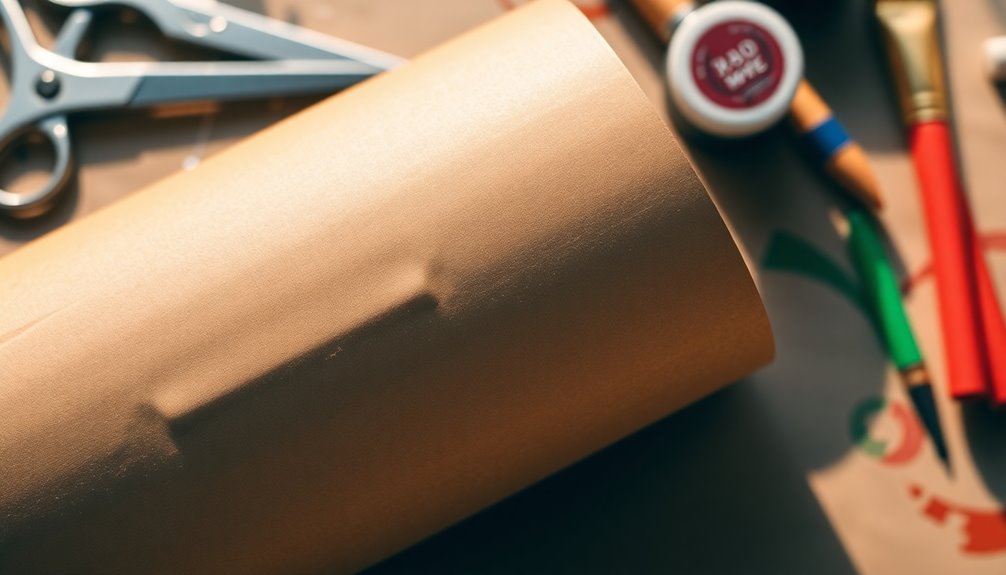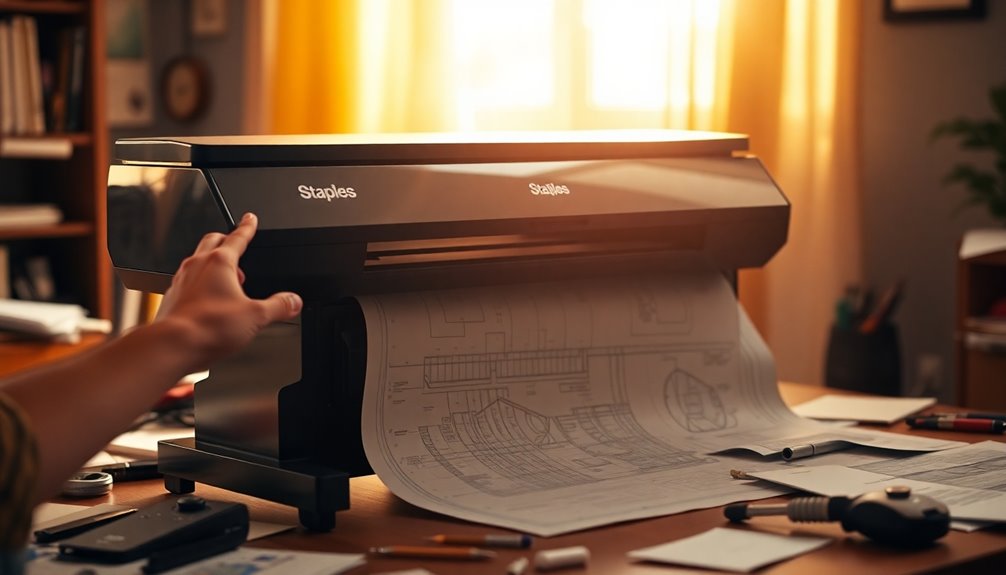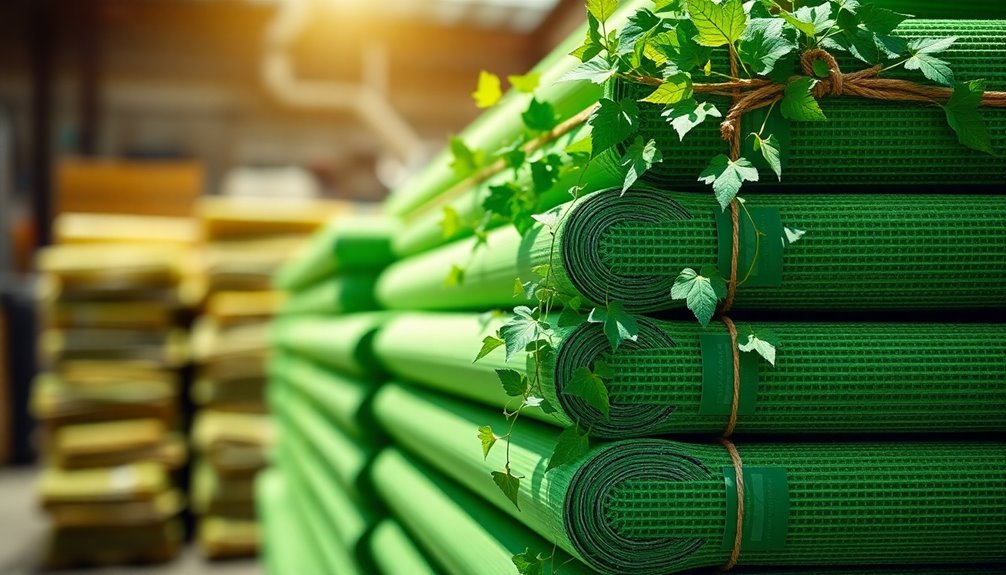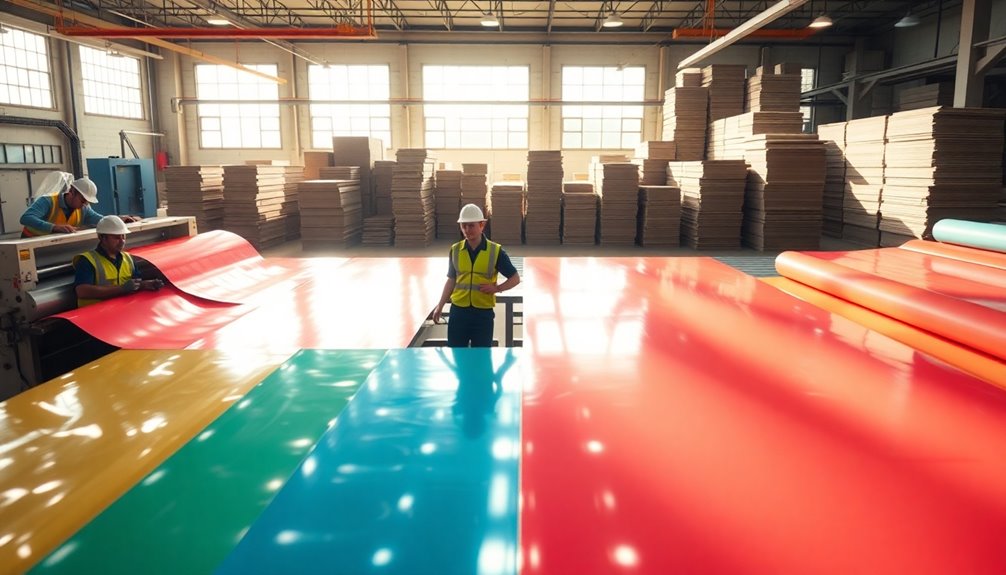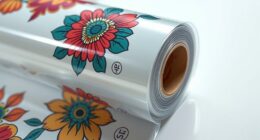Kraft paper's popularity stems from its strength, eco-friendliness, and versatility. You'll love that it's durable, making it perfect for packaging and crafts. The material's high cellulose content guarantees it withstands wear and tear, while its biodegradable and recyclable nature appeals to environmentally conscious consumers. It's cost-effective too, reducing shipping and manufacturing costs. Plus, with the rise of e-commerce, the demand for robust, sustainable packaging solutions has skyrocketed. Kraft paper effortlessly meets these needs across various industries. If you're curious about its many applications and benefits, there's much more to explore!
Key Takeaways
- Kraft paper is strong and durable, making it ideal for various applications, including packaging and crafting.
- It is eco-friendly, being biodegradable and recyclable, appealing to sustainability-conscious consumers.
- The versatility of kraft paper allows for use in food packaging, e-commerce, and industrial applications.
- Its cost-effectiveness and lightweight nature reduce shipping costs and waste, enhancing economic advantages.
- Growing consumer awareness of environmental issues drives the increasing demand for sustainable packaging solutions like kraft paper.
What Is Kraft Paper?
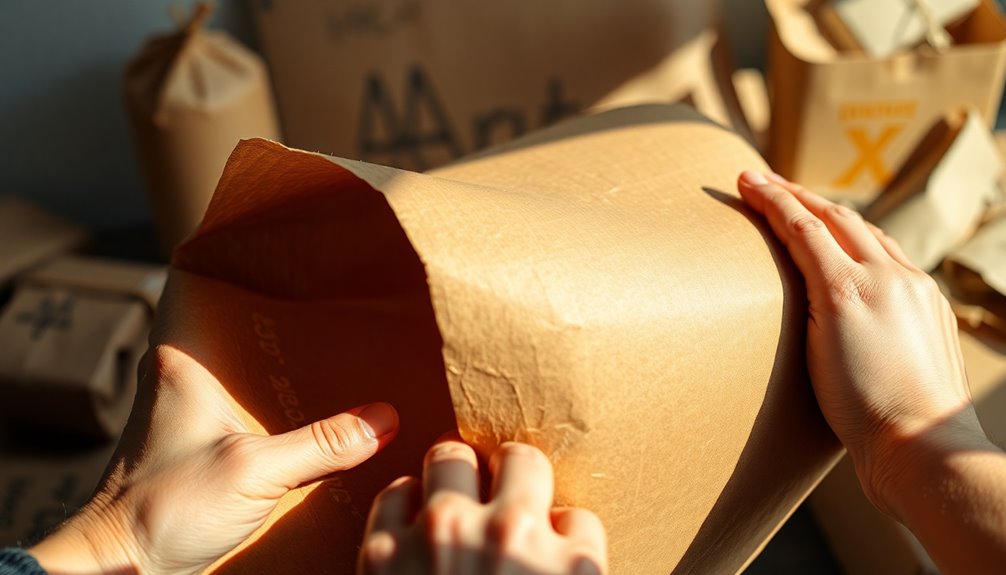
Kraft paper stands out as a strong and durable material that's created through a specific manufacturing process known as the kraft process. This process transforms wood into wood pulp by treating wood chips with sodium sulfide and sodium hydroxide, separating lignin from cellulose. The result is a paper with high cellulose content, enhancing its strength and versatility.
You'll notice that kraft paper is typically brown, a characteristic of its pulping process, but it also comes in various weights, thicknesses, and colors to suit different needs. Its textured and porous surface allows for high-quality printing and finishing, making it perfect for both packaging and crafting projects.
One of the standout features of kraft paper is its eco-friendly nature. It's biodegradable and recyclable, making it an appealing option for consumers and businesses focused on sustainability.
In a world increasingly concerned about environmental impact, using kraft paper in your packaging solutions not only provides strength and durability but also aligns with eco-conscious practices. Its versatility guarantees that it can meet a wide range of needs, reinforcing why kraft paper remains a popular choice in today's market.
Production Process of Kraft Paper

When you consider the production process of kraft paper, you'll find it begins with a chemical pulping process that effectively removes lignin from wood chips.
This step greatly enhances the paper's strength, making it more durable than regular paper.
Plus, innovations in production are constantly emerging, ensuring kraft paper meets modern sustainability and quality demands.
Chemical Pulping Process
The chemical pulping process, a cornerstone of kraft paper production, transforms wood chips into a robust paper product by effectively separating lignin from cellulose. Developed by Carl F. Dahl in the 1880s, this method uses sodium sulfide and sodium hydroxide to achieve its goals.
As wood chips are cooked in a caustic solution, you find that lignin is removed, resulting in high-quality pulp that retains some lignin. This retained lignin enhances the strength and durability of kraft paper, making it ideal for heavy-duty applications.
The kraft process allows for varying levels of bleaching, giving you options between unbleached brown kraft paper and bleached white kraft paper, catering to both aesthetic and functional needs. During production, screening and washing eliminate impurities, ensuring the final product meets high standards.
Today, innovations in kraft pulping continue to focus on sustainable practices and efficiency, all while maintaining the superior strength characteristics that make kraft paper so popular.
Strength Enhancement Techniques
Building on the robust foundation established by the chemical pulping process, various strength enhancement techniques further bolster kraft paper's durability and performance.
In kraft paper production, the chemical conversion of wood chips into pulp is essential. This process effectively removes lignin, which enhances the strength of the kraft paper. The remaining lignin plays an important role in maintaining overall durability, allowing the paper to withstand heavy-duty applications.
During production, the kraft process employs sodium sulfide and sodium hydroxide, which work together to eliminate excess lignin. This results in a product with high tensile strength, making it ideal for rigorous handling and shipping. You'll find that kraft paper is a preferred choice in the packaging industry, especially for corrugated boxes. Its ability to endure stress during transportation is unmatched, proving its worth in e-commerce packaging.
Moreover, innovations in pulping techniques continue to evolve, ensuring that the kraft paper maintains high-quality standards while meeting the demands of various industries.
Innovations in Production
Innovations in the production of kraft paper have transformed how manufacturers approach sustainability and efficiency. The kraft paper production process, developed by Carl F. Dahl in the 1880s, uses sodium sulfide and sodium hydroxide to treat wood chips, effectively separating lignin from cellulose. This chemical conversion enhances the paper's strength, giving it superior tensile strength compared to regular paper.
Today, innovations in production techniques like Swing Machines in American mills enable flexible production. This adaptability allows manufacturers to meet varying market demands for kraftliner sacks and sack kraft, ensuring they stay ahead in a competitive landscape.
Furthermore, the manufacturing process generates less pollution than traditional methods, reinforcing kraft paper as a sustainable option amidst rising environmental concerns.
As global demand for eco-friendly packaging solutions continues to rise, ongoing advancements in production are key. They're expected to increase kraft paper capacity, particularly in Europe, aligning with consumers' desires for sustainable products.
Types of Kraft Paper

When choosing Kraft paper, you'll encounter both coated and uncoated options, each suited for different applications.
You'll also see a distinction between virgin and recycled materials, with each type offering unique benefits.
Understanding these differences can help you select the right Kraft paper for your specific needs.
Coated vs. Uncoated Options
While selecting kraft paper for your packaging needs, understanding the differences between coated and uncoated options can greatly impact your choice. Coated unbleached kraft paper features a white additive, resulting in a clean surface that allows for high-quality printing while maintaining a lightweight and tear-resistant quality. This makes it ideal for businesses that want a polished look without sacrificing the natural aesthetic.
On the other hand, uncoated options retain their raw texture and are often preferred for their sustainability. Many uncoated kraft papers, including recycled kraft paper, appeal to environmentally conscious consumers. Each type serves distinct purposes across various industries, with specific characteristics catering to different packaging and branding needs.
Here's a quick comparison:
| Feature | Coated Unbleached Kraft Paper | Uncoated Options |
|---|---|---|
| Appearance | Clean, smooth surface | Natural, textured look |
| Printing Quality | High-quality printing | Limited printing options |
| Structural Strength | Good for lightweight items | Varies based on thickness |
Consider these factors to choose the best option for your packaging strategy!
Virgin vs. Recycled Material
Choosing between virgin and recycled material for your kraft paper can greatly impact your packaging strategy. Virgin Kraft paper, made from raw pulp sourced directly from trees, offers superior structural integrity and is ideal for high-quality packaging applications. This strength makes it a popular choice for food packaging and premium products.
However, the production of virgin Kraft typically involves more intensive resource use, contributing to a higher environmental impact.
On the other hand, Recycled Kraft paper, produced from post-consumer waste, presents an eco-friendly alternative. It appeals to sustainability-conscious consumers while still maintaining good strength and durability for general packaging and craft projects.
By choosing recycled options, you'll not only reduce landfill waste but also promote a circular economy.
Both options have their place in various packaging applications, but your choice can considerably influence your company's sustainability profile. If you prioritize environmental considerations, Recycled Kraft can bolster your eco-friendly image, while Virgin Kraft may be essential for specific premium needs.
Ultimately, weighing the strengths and environmental impacts of each type will help you align your packaging strategy with your values and goals.
Applications of Kraft Paper

Kraft paper has become a go-to choice for various applications, thanks to its strength and versatility. In the e-commerce industry, you'll find kraft paper widely used for packaging products, ensuring they withstand the rigors of shipping and handling. Its durable nature makes it ideal for protecting items during transit, so you can trust it to keep your purchases safe.
When it comes to food packaging, kraft paper shines as it complies with safety regulations while providing a moisture-resistant barrier. You'll often see it used for baked goods and takeout containers, making it a reliable choice for food businesses.
The crafting community also loves kraft paper for its versatility. Whether you're scrapbooking, card making, or tackling DIY projects, you can easily customize it with various designs to fit your vision.
In retail, consumers appreciate kraft paper for wrapping gifts and creating eco-friendly shopping bags. Its environmentally friendly appeal resonates with many shoppers seeking sustainable options.
Finally, in industrial packaging, kraft paper provides strength and reliability for heavy-duty items, ensuring they're well-protected during shipping. Overall, kraft paper's numerous applications make it an indispensable material across various industries.
Environmental Benefits

As more industries recognize the advantages of kraft paper, its environmental benefits become increasingly significant. Kraft paper is biodegradable, breaking down naturally within weeks, which drastically reduces its environmental footprint compared to plastic alternatives.
Made from renewable wood pulp, it supports sustainable forestry practices, ensuring that resources are managed responsibly.
You'll be pleased to know that kraft paper is also recyclable, promoting a circular economy. Unlike plastic, which often ends up in landfills, kraft paper can be easily repurposed, lowering its overall environmental impact.
The manufacturing process generates less pollution than plastic production, making it a cleaner choice for the planet.
Furthermore, kraft paper's ability to be composted enhances its eco-friendly profile, allowing businesses to reduce waste effectively.
With 94 countries implementing partial or complete bans on plastics, kraft paper has emerged as a sustainable alternative that resonates with global climate action initiatives.
Economic Advantages

When it comes to packaging solutions, kraft paper stands out for its economic advantages. It's a cost-effective choice, thanks to its low manufacturing costs. Produced from readily available wood sources like bamboo and pine, kraft paper offers businesses an economical option without sacrificing quality.
Consider these key points:
- Lightweight Nature: Reduces shipping costs, saving you money on logistics.
- High Strength and Durability: Guarantees less waste and longer usage, which helps minimize packaging costs.
- Economic Efficiency: The manufacturing process recovers and reuses chemicals, lowering production costs and waste.
With a projected global market value of USD 18.7 billion by 2025, the increasing demand for kraft paper highlights its financial benefits across various industries.
Companies can take advantage of kraft paper's strength and durability, making it a smart investment for both consumers and businesses. By choosing kraft paper, you're not just opting for an eco-friendly solution—you're also making a financially sound decision that enhances overall economic efficiency.
Growing Market Demand
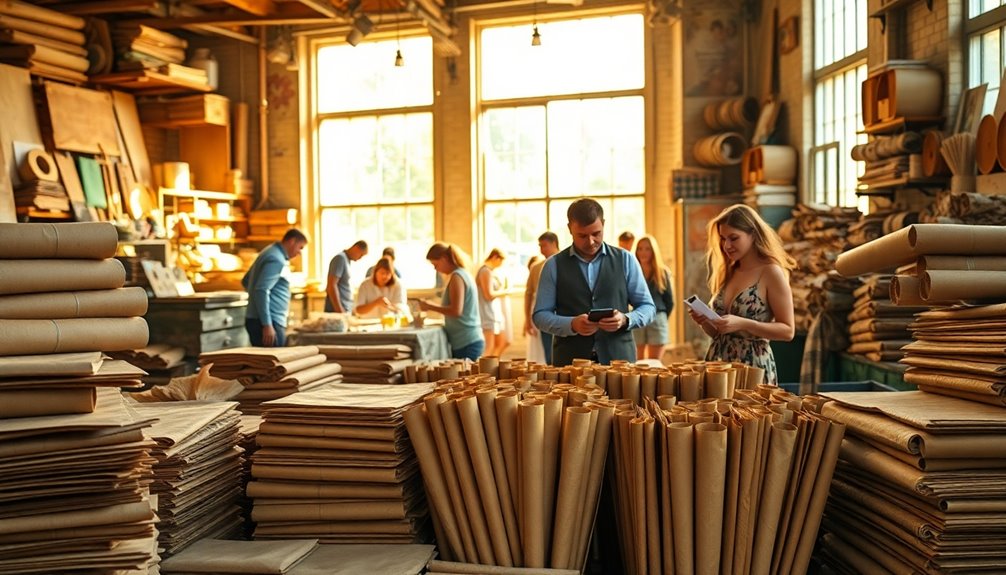
A noticeable shift toward sustainable packaging solutions is driving the growing demand for kraft paper across various industries. As more businesses aim to reduce their environmental impact, you're likely to see a change from traditional materials to kraft paper, which is both biodegradable and durable.
E-commerce growth, in particular, is greatly increasing the need for robust packaging options. In the U.S. market, many companies are opting for kraft paper bags instead of corrugated boxes, aligning with consumer preferences for eco-friendly alternatives.
Consumer awareness about climate change and environmental degradation is now influencing purchasing decisions. With urbanization and population growth accelerating, industries must adapt to evolving preferences for sustainable packaging.
The global demand for kraft paper is projected to reach USD 18.7 billion by 2025, underscoring its rising popularity. Additionally, Europe's export of 610,000 MT of kraft paper to Asia in 2022 highlights the strong international trade dynamics and reliance on kraft paper for various applications.
As consumers and businesses alike prioritize sustainability, kraft paper's prominence in the packaging landscape is set to continue expanding.
Impact of E-Commerce
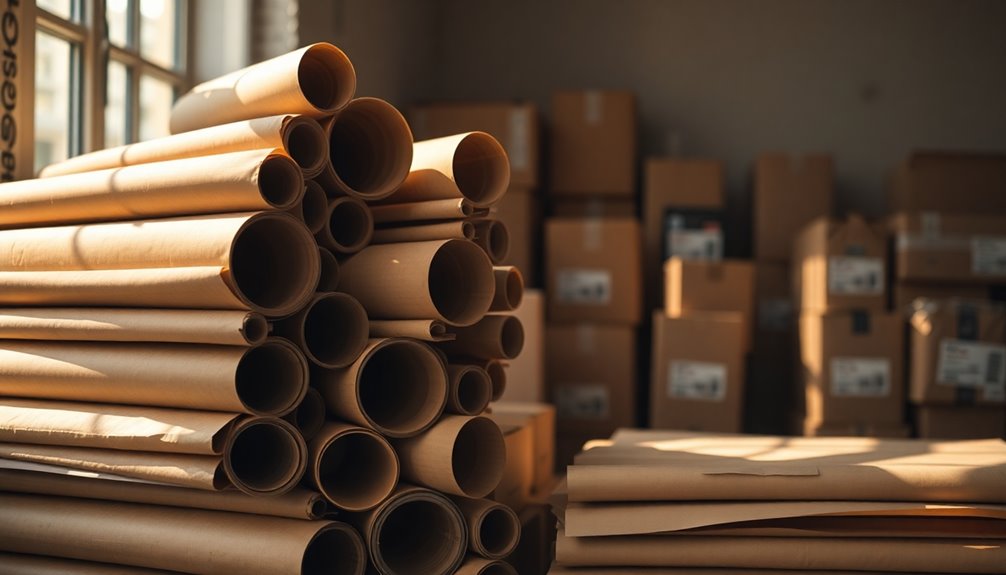
E-commerce has transformed how businesses approach packaging, leading to a surge in demand for kraft paper. As online retail continues to expand, companies are shifting from traditional materials to sustainable packaging solutions. Kraft paper stands out due to its durability and protective qualities, making it a popular choice.
Consider these factors driving the rise in demand for kraft paper:
- Eco-friendly alternative: With 94 countries banning or restricting plastic, kraft paper offers a biodegradable solution that aligns with consumer preferences.
- Versatile applications: Kraft paper can be used for bags, wraps, and boxes, catering to various packaging needs across different industries.
- Sustainable production: Major companies are investing in new kraft production sites, ensuring they can meet the increasing demand for eco-friendly materials.
The e-commerce boom hasn't only highlighted the need for effective packaging but has also underscored the importance of sustainability.
As you navigate the online shopping landscape, you'll likely notice the growing prevalence of kraft paper, reinforcing its position as a leading choice in the quest for sustainable packaging.
Future Trends in Kraft Paper

Looking ahead, the kraft paper industry is poised for significant growth, driven by a clear change towards sustainable packaging solutions. As consumer awareness rises, more people are demanding eco-friendly products, leading to an increasing preference for recycled kraft paper.
This trend aligns perfectly with the ongoing e-commerce boom, where businesses are evolving from plastic packaging alternatives to more sustainable options that appeal to environmentally conscious shoppers.
Innovations in kraft paper manufacturing are also on the horizon, promising enhanced strength and versatility. These advancements will make kraft paper suitable for a broader range of applications, further boosting its market appeal.
Additionally, climate action initiatives are likely to encourage companies to invest in renewable energy and sustainable practices within their production processes.
With the kraft paper market projected to reach USD 18.7 billion by 2025, the future looks bright. As more brands adopt sustainable packaging solutions, you can expect an ever-growing array of eco-friendly products lining the shelves, all wrapped in kraft paper.
This change not only benefits the environment but also aligns with your values as a conscious consumer.
Frequently Asked Questions
What Are the Advantages of Kraft Paper?
Kraft paper offers several advantages that make it an excellent choice for your packaging needs.
Its durability and tear-resistance guarantee it can handle heavy items without tearing.
You'll appreciate its eco-friendly qualities, as it's biodegradable and recyclable.
Plus, it's cost-effective, reducing your shipping expenses due to its lightweight nature.
With its versatility for various applications and natural look, kraft paper allows you to create appealing, sustainable packaging that resonates with environmentally conscious consumers.
What Is the Difference Between Kraft Paper and Normal Paper?
Kraft paper and normal paper differ mainly in strength and durability.
You'll notice that kraft paper, made from unbleached wood pulp, has a natural brown color and higher tensile strength, making it more resistant to tearing and moisture.
Normal paper, often bleached and smoother, is better suited for standard printing but can be weaker.
When you need a robust material for heavy-duty tasks, kraft paper's advantages become clear.
Is Kraft Paper Good Quality?
Yes, kraft paper is considered good quality for many reasons.
Its high tensile strength makes it durable, perfect for heavy-duty applications. You'll appreciate its resistance to tearing due to the lignin retained during production.
Plus, it comes in various weights and thicknesses, allowing you to choose what's best for your needs.
If you're looking for a sustainable option, its biodegradable and recyclable qualities enhance its value even further.
Why Is Kraft Paper so Expensive?
Kraft paper's expense comes from several factors.
You'll notice that its production requires a complex chemical process, which demands significant energy and resources.
If you look closely, virgin kraft paper costs more due to sustainable forestry practices.
Plus, the increasing demand for eco-friendly packaging allows manufacturers to charge premiums.
Recycling processes, while beneficial, also add costs associated with collection and processing, making kraft paper a pricier option in the market.
Conclusion
To sum up, kraft paper's popularity stems from its versatility, eco-friendliness, and cost-effectiveness. Whether you're using it for packaging, crafts, or industrial applications, its strength and sustainability make it a top choice. As e-commerce continues to grow, the demand for kraft paper will likely rise, paving the way for innovative uses and production methods. Embracing kraft paper not only supports your needs but also contributes to a greener planet, making it a smart choice for everyone.

